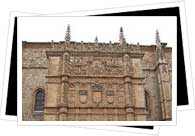Plateresque Architecture in Spain While the rest of Europe embraced the Italian Renaissance, Spain has always demonstrated a flare for the decorative and therefore didn't succumb quite as easily to the Renaissance's return to basic forms and decorative sobriety. In fact, until the end of the Renaissance, when the austere Herrera-style made a brief but monumental mark on Spain, Spanish architects seemed to do exactly the opposite. However, the Plateresque style, which made its stylish mark on Spain during the 15th and 16th centuries, has an unmissable presence in Salamanca.
While the rest of Europe embraced the Italian Renaissance, Spain has always demonstrated a flare for the decorative and therefore didn't succumb quite as easily to the Renaissance's return to basic forms and decorative sobriety. In fact, until the end of the Renaissance, when the austere Herrera-style made a brief but monumental mark on Spain, Spanish architects seemed to do exactly the opposite. However, the Plateresque style, which made its stylish mark on Spain during the 15th and 16th centuries, has an unmissable presence in Salamanca.
Plateresque Architecture Characteristics
One major difference between the architecture of Spain and that of the rest of Europe is Spain's Moorish history. Spain, especially in the southern regions, boasts incredible displays of Moorish and Mudejar (Moorish-inspired) architecture- just take a look at Sevilla's Alcázar, Granada's La Alhambra, or Córdoba's Mezquita! As Gothic architecture in Europe eventually turned over to Renaissance, Spain was not ready to let go of the magnificence of its Gothic and Moorish components. For this very reason, in Plateresque buildings you will see a great deal of leftovers from the country's medieval architectural styles.
While the High Renaissance was essentially a structural architectural movement, the Plateresque branch focused on the decorative side. For this reason, extremely stylized façades featuring the integration of sculptures, busts, and floral and organic motifs are the most common feature of the Plateresque style.
Plateresque Architecture in Salamanca
While half of Salamanca seems to bask in Plateresque adornment, the most famous manifestation of Plateresque architecture in Salamanca is the famed Salamanca University building- one look at its façade will have you lost in the surface-covering decoration. A few other examples include East Salamanca's Convento de las Dueñas (Convent of the Dueñas) and the West Salamanca Quarter's Palacio de Monterrey (Monterrey Palace) and Casa de las Muertes (House of the Dead).